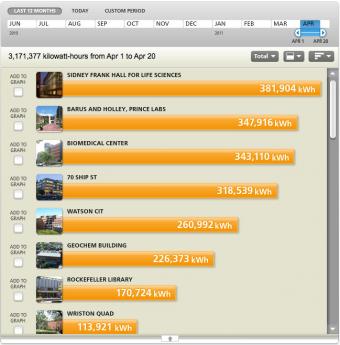PROVIDENCE, R.I. [Brown University] — Want to know how much energy is being used by your dormitory or the building in which you work? Now you can find out — in real time — courtesy of a new website.
Brown’s Department of Facilities Management and EcoReps — undergraduates who educate their classmates about environmental issues — worked with Lucid Design Group to develop a Building Dashboard for Brown. The site tracks energy use at about 30 buildings, slightly more than 12 percent of the properties owned or operated by Brown. More buildings will be added as the facilities staff outfits them with special meters.
Visitors will find lots of energy-consumption information on the site. The centerpiece is the real-time log of electricity use in each building. The largest energy users are research laboratories, including Prince Lab, the Bio-Medical Center, 70 Ship St., Geo-Chem, and Sidney Frank Hall for Life Sciences. Among the energy sippers are Hegeman Hall, Rhode Island Hall, and University Hall. A typical office building uses about 350 kilowatt hours of energy per day, according to facilities.
Chris Powell, director of sustainable energy and environmental initiatives at Brown, said the goal behind the site is to raise awareness of the University’s carbon footprint and to encourage students and staff to conserve. Brown spends roughly $10 million annually on electricity, he said.
“Anything we can do to get this (cost) smaller is a benefit to the University as a whole,” he said.
Besides the energy-use tracker, the site, which cost $30,000 to set up, lists students and staff who commit to various energy-saving tactics, offers energy-efficiency tips, has a whiteboard for posting comments, and houses the University’s Twitter feed and local weather forecasts.
The University has hired a consultant to evaluate energy-saving ideas for dormitories, especially regarding heat use, and plans to investigate installing meters that would track heat consumption in winter, Powell said.
Brown has made great strides in reducing its greenhouse gas emissions. The University has lopped off 21 percent of carbon emission from buildings on campus since fiscal year 2007 and is already halfway toward meeting President Ruth Simmons’s goal of reducing the University’s carbon footprint by 42 percent by 2020.
The dashboard should help that effort, Powell said, noting that it is but one tool to showcase energy use — and misuse. “We know our sole purpose was to educate the Brown community, particularly the students, about their carbon footprint, and how they can impact it in a positive way,” he said.

